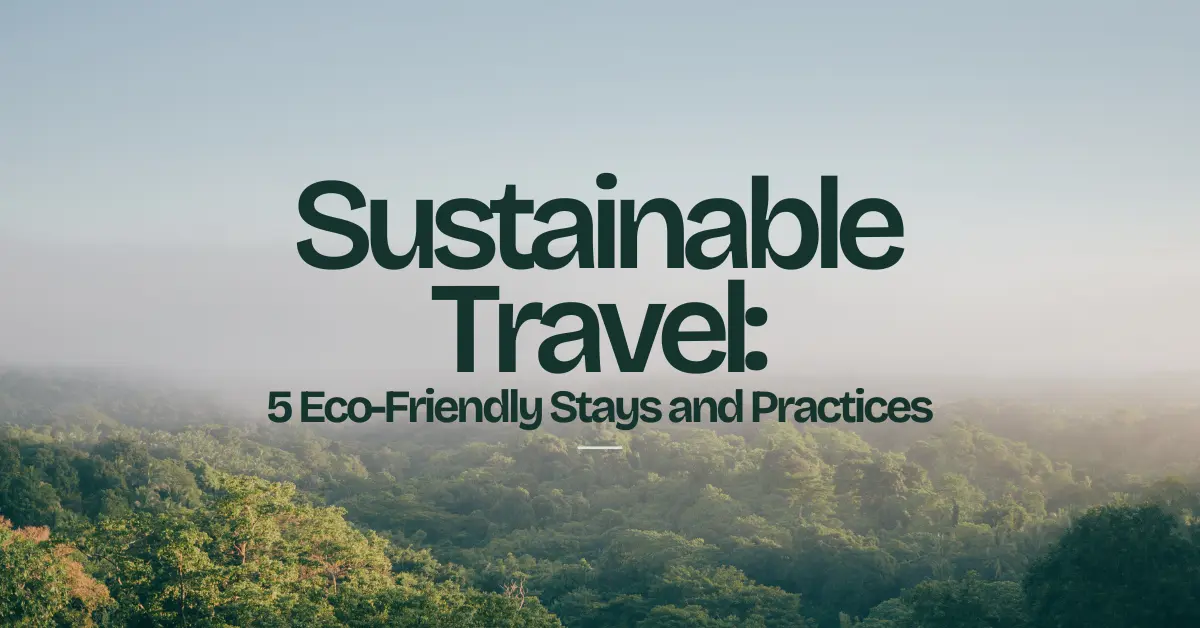
Sustainable Travel: 5 Eco-Friendly Stays and Practices
- 72
- 0
- 0
Sustainable travel is all about exploring the world while protecting the environment and respecting local cultures. It means making mindful choices to reduce your impact on nature, like staying in eco-friendly accommodations, using public transport, and avoiding single-use plastics. Why is it important? Because our planet’s resources are limited, and tourism can harm nature if not done responsibly. By practising sustainable travel, you help preserve the beauty of destinations, protect wildlife, and support local communities.
Simple actions, like staying in green-certified hotels, eating local food, or carrying reusable water bottles, can make a big difference. Sustainable travel ensures we enjoy the world responsibly while leaving it better for future generations. Travel smart, travel green.
Sustainable Travel: 5 Eco-Friendly Stays and Practices
Travelling is wonderful, but it’s important to think about how our trips affect the environment. More and more travellers want to make better choices that help protect our planet. In this blog post, we’ll share 5 amazing eco-friendly places to stay and useful tips to make your travels more sustainable.
Tree House Lodge, Costa Rica

The Tree House Lodge in Costa Rica shows how tourism and nature can work together perfectly. Built using fallen trees and recycled materials, these beautiful tree houses let you stay right in the rainforest without harming it.
What makes this place special:
- Solar panels provide all the electricity
- They collect rainwater and clean it for drinking
- The lodge grows its organic food
- Local people work at the lodge
- They support local wildlife protection programs
Practical tip: Book your stay during the dry season (December to April) to use less energy for cooling and make the most of solar power.
Six Senses Ninh Van Bay, Vietnam

This coastal resort proves that luxury and environmental care can go hand in hand. Located on a private bay, Six Senses takes serious steps to protect both the land and sea.
Their green practices include:
- A water bottling plant that removes the need for plastic bottles
- An organic garden that supplies the kitchen
- Coral reef protection programs
- Energy-efficient building design
- Waste recycling and composting systems
Good to know: The resort offers free tours of their sustainability projects, so you can learn how they work to protect the environment.
Whitepod Eco-Resort, Switzerland

High in the Swiss Alps, Whitepod shows how winter tourism can be eco-friendly. The resort uses dome-shaped pods that need very little energy to heat and cool.
Here’s what they do right:
- Pods use 30% less energy than traditional hotel rooms
- They limit the number of guests to reduce environmental impact
- All food comes from local farms
- Walking is the main way to get around the resort
- They use water-saving fixtures in all pods
Travel tip: Visit during spring or fall to avoid peak energy use times and enjoy lower prices.
El Nido Resorts, Philippines

These island resorts in the Philippines take marine conservation seriously while offering beautiful places to stay. Their work shows how tourism can help protect ocean life.
Their environmental programs:
- They clean the beaches daily
- Staff members are trained in marine conservation
- They work with local communities on recycling programs
- Guests can join coral-planting activities
- They use electric boats for island tours
Important note: The best time to visit is during the dry season (November to May) when the sea is calmer and activities need less fuel.
Chumbe Island Resort, Tanzania

This small island resort near Zanzibar is a perfect example of eco-tourism. They turned a coral reef into a protected area and built a small resort to help pay for conservation.
What they do for the environment:
- They use zero-emission technologies
- Rainwater harvesting provides all water needs
- Solar panels power everything
- Composting toilets saves water
- They teach local children about marine conservation
Helpful tip: Plan your visit between June and October when winds are lighter and solar power is most effective.
Practical Tips for Sustainable Travel
No matter where you stay, here are some simple ways to make your travels better for the environment:
Pack Smart
- Bring a reusable water bottle
- Take a cloth shopping bag
- Pack biodegradable soap and shampoo
- Include a reusable straw and cutlery
- Take a quick-dry towel to save on laundry
Travel Better
- Choose direct flights when possible
- Use public transport or bike at your destination
- Walk when you can
- Join group tours instead of private ones
- Pick airlines that use newer, more efficient planes
Watch Your Water and Energy Use
- Turn off lights and AC when leaving your room
- Take shorter showers
- Reuse towels and bed sheets
- Unplug chargers when not in use
- Use natural light when possible
Support Local Communities
- Buy from local shops
- Eat at local restaurants
- Take tours with local guides
- Learn basic words in the local language
- Respect local customs
Reduce Waste
- Say no to plastic bags
- Carry a reusable water bottle
- Choose products with less packaging
- Keep digital copies of documents instead of printing
- Properly dispose of trash
Making Better Travel Choices
Each small choice we make while travelling adds up to make a big difference. By picking eco-friendly places to stay and following sustainable practices, we can help protect the beautiful places we visit.
Remember that sustainable travel isn’t about giving up comfort – it’s about making smart choices that help both you and the environment. The places we’ve shared here show that you can have an amazing trip while caring for our planet.
Before you book your next trip, think about how you can make it more eco-friendly. Look for places that care about the environment, pack things you can reuse, and try to leave each place better than you found it.
Final Thoughts
More hotels and resorts are now taking steps to protect the environment. This means travellers have more choices for eco-friendly stays than ever before. By choosing these places and following simple sustainable practices, we can all help make tourism better for our planet.
Start with small changes and build from there. Every eco-friendly choice helps, and together we can make tourism work better for everyone – travellers, local communities, and our environment.
Remember, the goal isn’t to be perfect but to do better. Each sustainable choice we make helps protect the amazing places we love to visit, ensuring they stay beautiful for future travellers to enjoy.
FAQs
Q: What is sustainable travel?
A: Sustainable travel minimizes environmental impact, promotes local culture, and ensures eco-friendly practices like staying in green-certified accommodations, reducing waste, and supporting local businesses.
Q: How can I choose eco-friendly stays?
A: Look for certifications like LEED, Green Key, or EarthCheck. Choose stays that use renewable energy, offer water-saving systems, and actively support sustainable tourism initiatives.
Q: What are some eco-friendly practices while travelling?
A: Reduce plastic use, carry reusable bottles, use public transport or bikes, and respect local customs. Opt for minimal packaging and eco-conscious souvenirs.
Q: Why is supporting local businesses important in sustainable travel?
A: Supporting local businesses boosts the local economy, preserves cultural heritage, and reduces the carbon footprint linked to importing goods or services from distant locations.
Q: How does sustainable travel benefit the environment?
A: It reduces pollution, conserves resources, protects biodiversity, and encourages eco-conscious choices. Travelers can enjoy nature while ensuring its preservation for future generations.
Also Read:
5 Top Wellness Retreats to Visit in 2025
References:
https://en.wikipedia.org/wiki/Sustainable_tourism
https://en.wikipedia.org/wiki/Ecotourism
https://www.researchgate.net/publication/381172760_Sustainability_Practices_in_Eco-Friendly_Resorts
Disclaimer: The information shared is for general awareness about sustainable travel. Practices may vary by location. Verify details with service providers. We are not responsible for personal decisions or outcomes based on this content.



